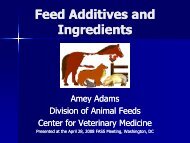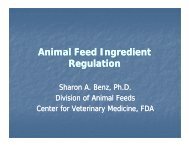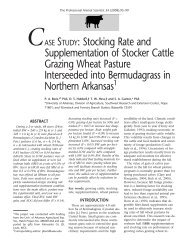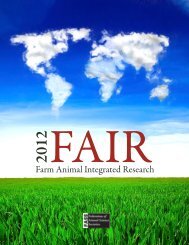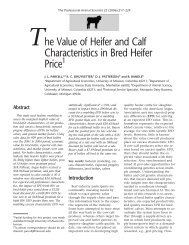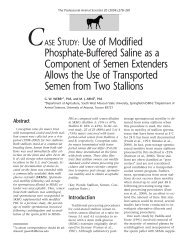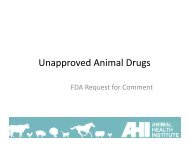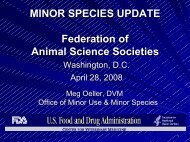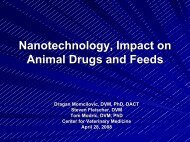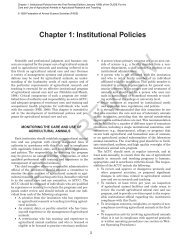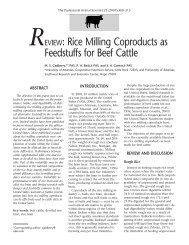IFT Review of Antibiotic Resistance - Federation of Animal Science ...
IFT Review of Antibiotic Resistance - Federation of Animal Science ...
IFT Review of Antibiotic Resistance - Federation of Animal Science ...
You also want an ePaper? Increase the reach of your titles
YUMPU automatically turns print PDFs into web optimized ePapers that Google loves.
Antimicrobial<br />
<strong>Resistance</strong>:<br />
Implications for the Food System<br />
An Expert Report<br />
<strong>IFT</strong> Foundation<br />
Sponsored by the
Intellectual Contributors<br />
Frank Busta<br />
University <strong>of</strong> Minnesota<br />
Bruce Cords<br />
Ecolab<br />
Scott Hurd<br />
Director, WHO Collaborating Center<br />
for Risk Assessment and Hazard<br />
Identification in Foods <strong>of</strong> <strong>Animal</strong> Origin<br />
Richard Isaacson<br />
University <strong>of</strong> Minnesota<br />
Michael Davidson<br />
University <strong>of</strong> Tennessee<br />
Karl Matthews<br />
Rutgers University<br />
Michael Doyle, Panel Chair<br />
University it <strong>of</strong> Georgia<br />
John Maurer<br />
University it <strong>of</strong> Georgia<br />
John Hawke<br />
Louisiana State University<br />
Jianghong Meng<br />
University <strong>of</strong> Maryland
Intellectual Contributors<br />
Thomas Montville<br />
Rutgers University<br />
Anne Vidaver<br />
University <strong>of</strong> Nebraska<br />
Thomas Shryock<br />
Elanco <strong>Animal</strong> Health<br />
Lyle Vogel<br />
American Veterinary Medical Association<br />
John S<strong>of</strong>os<br />
Colorado State University<br />
<strong>IFT</strong> Staff: Jennifer McEntire<br />
Rosetta Newsome<br />
Fred Shank
Incidence <strong>of</strong> Foo<br />
dborne Illness in<br />
United States<br />
● U.S. Centers for Disease Control and Prevention<br />
estimates 76 million cases <strong>of</strong> foodborne illness<br />
annually<br />
▲ Includes 325,000 hospitalizations and 5,000<br />
deaths<br />
P. S. Mead et al. 5:607 (1999)
Leading Bacterio<br />
logical Causes <strong>of</strong><br />
Enteric Foodborne Illness in USA<br />
●<br />
Campylobacter jejuni –estimated 2.4 million cases/yr<br />
● Salmonella sp. – estimated 1. 4 million cases/yr<br />
● E. coli O157:H7 – estimated 73,000 cases/yr<br />
P. Mead et al. Emerging Infect.<br />
Dis. 5:607-625 625 (1999)
Principal Source<br />
es <strong>of</strong> Foodborne<br />
Pathogens<br />
● <strong>Animal</strong>s used in food production<br />
▲ Cattle – E. coli O157:H7 (EHEC), Salmonella,<br />
Campylobacter<br />
▲ Swine – Salmonella, Campylobacter<br />
▲ Poultry – Campylobacter, Salmonella
Antimicrobials<br />
Used in Food<br />
Production and Food Processing<br />
● Important to reduce and control foodborne<br />
pathogens in animals use<br />
ed for foods and the further<br />
processing <strong>of</strong> animals
<strong>Antibiotic</strong> Applications<br />
●<br />
Antimicrobials used during food production and manufacturing to improve the efficiency <strong>of</strong><br />
the system, and increase the safety and quality <strong>of</strong> the product<br />
▲ <strong>Animal</strong> Husbandry in USA – <strong>Antibiotic</strong>s<br />
♦ Poultry – 8.4 billion broilers and 26<br />
64 million turkeys (2004)<br />
■ 10,000 – 20,000 broilers per house and 5,000 – 10,000 turkeys per group<br />
♦ Swine – 103 million hogs slaughtered for food (2005)<br />
■ >75% <strong>of</strong> swine grown in operations with >5000 head<br />
♦ Beef Cattle – 37 million head slaughtered (2004)<br />
■ Ca. 83% <strong>of</strong> feedlots use ≥1 antibiotic for disease prophylaxis or to increase<br />
feed efficiency<br />
♦ Dairy Cattle – 9.12 million head in milk production (2001)<br />
■ <strong>Antibiotic</strong>s used to treat mastitis<br />
♦ Veal Calves – raised individually in<br />
stalls until 16-18 weeks <strong>of</strong> age<br />
■ <strong>Antibiotic</strong>s used to treat respiratory and gastrointestinal diseases and for<br />
disease prophylaxis<br />
<strong>Antibiotic</strong> uses:<br />
Therapeutic, including subtherapeutic to prevent disease or control pathogens (ca.<br />
95% <strong>of</strong> antibiotic usage)<br />
Non-therapeutic uses: Promote growth rate and feed efficiency
<strong>Antibiotic</strong> Applications<br />
▲ Aquaculture – <strong>Antibiotic</strong>s only used in U.S. to treat<br />
disease; not for growth promotion<br />
♦ 49 million pounds <strong>of</strong> salmon, 20 million pounds <strong>of</strong><br />
tilapia, 10 million pounds <strong>of</strong> striped bass (USA, 2000),<br />
630 million pounds <strong>of</strong> catfish, 46 million pounds <strong>of</strong><br />
trout (USA, 2003)<br />
♦ Catfish grown in 10- to 20-acre ponds with 10,000<br />
fish/acre<br />
▲ Plant Agriculture – <strong>Antibiotic</strong>s to control bacterial<br />
diseases and fungicides to<br />
control fungi<br />
♦ Fruit trees account for most <strong>of</strong> antibiotic i use on plants<br />
♦ Most antimicrobials used on plants are fungicides<br />
▲ Human Medicine – Antibio<br />
otics used to treat disease and<br />
prevent infection
<strong>Antibiotic</strong> Usage Data<br />
●<br />
Exact amount <strong>of</strong> antibiotics used in animal production is<br />
unknown but likely comparabl<br />
e to amount used in human<br />
medicine<br />
▲ <strong>Animal</strong>s – est. 21.7 million<br />
use; 2004)<br />
pounds (95% for therapeutic<br />
▲ Aquaculture – 65,000 pounds annually (2003)<br />
▲ Plants – 52 million pounds<br />
<strong>of</strong> fungicides id and 44,000<br />
pounds <strong>of</strong> antibiotics (2004)<br />
▲ Human – unknown (est. 4.<br />
5 million to 32 million pounds<br />
depending on organizationn providing estimates)
Monitoring <strong>Antibiotic</strong> <strong>Resistance</strong><br />
●<br />
National Antimicrobial <strong>Resistance</strong> Monitoring System for<br />
Enteric Bacteria (NARMS)<br />
▲ U.S. antibiotic resistance monitoring system for foodrelated<br />
bacteria – CDC, FDA, USDA<br />
▲ Purpose – monitor change<br />
es in susceptibilities <strong>of</strong> zoonotic<br />
pathogens in humans, animals and animal products<br />
♦ Bacterial isolates from human and animal clinical<br />
specimens, healthy farm<br />
animals, and raw foods <strong>of</strong><br />
animal origin<br />
■ Salmonella, E. coli,<br />
Campylobacter, Enterococcus<br />
♦ Determine Minimal Inhibitory Concentration (MIC) <strong>of</strong><br />
important antimicrobial classes used in human and<br />
animal medicine
Trends in Percentage <strong>of</strong> <strong>Antibiotic</strong>-Resistant Salmonella Newport<br />
Isolated from Human Cases, a <strong>Animal</strong>s and <strong>Animal</strong> Products, b and<br />
Retail Meats c in the United States<br />
<strong>Antibiotic</strong> <strong>Resistance</strong><br />
Humans<br />
1996 2001<br />
None <strong>of</strong> 14 agents 82 65<br />
5 or more agents 6 27<br />
8 or more agents 4 25<br />
MDR-AmpC 0 25<br />
Cipr<strong>of</strong>loxacin 0<br />
Cefti<strong>of</strong>ur 4 27<br />
Ampicillin 6 29<br />
Tetracycline 8 30<br />
Trimethoprim-Sulfa 4 2<br />
a<br />
CDC NARMS<br />
b<br />
USDA NARMS<br />
c<br />
FDA NARMS<br />
<strong>Animal</strong>s & Products<br />
Retail<br />
Meats<br />
2002 2000 2002 2003 2002<br />
73<br />
23<br />
22<br />
22<br />
0 0 0 0 0<br />
22 75 78 74 62<br />
24 76 80 74 62<br />
25 78 83 77 62<br />
4 19 2 0
Changes in the incidence <strong>of</strong> foodborne illness, and corresponding changes in<br />
prevalence <strong>of</strong> antibiotic-resistant foodborne pathogens in U.S.<br />
Year(s)<br />
Organism<br />
Case rate<br />
(per 100,000)<br />
Relative<br />
Decrease<br />
or increase<br />
%<br />
Resistant<br />
Case rate<br />
(per 100,000)<br />
Relative<br />
decrease<br />
or increase<br />
1996-98 Salmonella 15.9<br />
31% (2 or more 4.9<br />
antibiotics, 1996)<br />
2004 14.7 8% decrease 16% (2 or more 2.4 51%<br />
antibiotics, 2002)<br />
decrease<br />
1996-98 Salmonella<br />
4.9<br />
34% (ACSSuT, 1996) 1.7<br />
Typhimurium<br />
2004 29 2.9 41% decr<br />
rease 21% (ACSSuT, 2002) 06 0.6 65%<br />
decrease<br />
1996-98 Salmonella<br />
1.2<br />
8% (2 or more<br />
0.1<br />
Newport<br />
antibiotics, 1996)<br />
2004 1.7 41% increase<br />
25% (2 or more 0.4 300%<br />
antibiotics, 2002)<br />
increase<br />
1996-98 Campylobacter 18.7<br />
13% (cipr<strong>of</strong>loxacin 2.4<br />
resistance, 1997)<br />
2004 12.9 31% decrease<br />
20% (cipr<strong>of</strong>loxacin 2.6 8% increase<br />
resistance, 2002)
Relative rates compared with 1996-1998 baseline period <strong>of</strong> laboratory-<br />
diagnosed d cases <strong>of</strong> infection with th<br />
he six most commonly isolated<br />
Salmonella serotypes, by year – Foodborne Disease Active Surveillance<br />
Network, United States, 1996-2006
Risk Factors for Human Infection by<br />
<strong>Antibiotic</strong>-Resistant Foodborne Pathogens<br />
●<br />
●<br />
Very few data regarding food animal-to-human transfer <strong>of</strong><br />
antimicrobial resistance to indicate more frequent or severe<br />
infections or increased morbidi<br />
ty and mortality<br />
Antimicrobial therapy is not necessary for recovery from most<br />
cases <strong>of</strong> foodborne illness<br />
▲ Most foodborne pathogens<br />
self-limiting limiting symptoms that<br />
typically cause mild to moderate<br />
resolve without treatment
Risk Factors for Human Infection by<br />
<strong>Antibiotic</strong>-Resistant Foodborne Pathogens<br />
●<br />
Most frequently identified risk factor for infection with antibiotic-resistant<br />
bacteria is prior exposure to antibiotics, including taking antibiotics for<br />
reasons other than foodborne illnesses<br />
▲<br />
▲<br />
Other risk factors are essentially the same as those for acquiring<br />
infections with antibiotic susceptible pathogens, which include:<br />
♦ Age (less than 5 or greater th<br />
han 50)<br />
♦ Pregnancy<br />
♦ Immunosuppression (chemotherapy, HIV infection, other illness)<br />
♦ Reduced liver or kidney funct<br />
tion<br />
Reasonable assumption the risk <strong>of</strong> treatment failure in immuno-<br />
microbial infections<br />
would be elevated<br />
compromised individuals with antibiotic-resistant
●<br />
Impact <strong>of</strong> <strong>Antibiotic</strong><br />
cUse Use, Non-Use, and<br />
<strong>Resistance</strong><br />
Human Health<br />
▲ Loss <strong>of</strong> treatment options or treatment failure for individuals seriously ill<br />
from antibiotic-resistant foodborne pathogen<br />
♦ Estimated that 40 – 50% <strong>of</strong> ho<br />
spitalized patients with salmonellosis<br />
are treated with antibiotics<br />
▲ Longer duration <strong>of</strong> illness when infected with antibiotic-resistant pathogen<br />
♦ Patients infected with fluoroqu<br />
inolone-resistant C. jejuni j had longer<br />
duration <strong>of</strong> illness than patients<br />
infected with fluoroquinolone-sensitive<br />
strains<br />
▲ Individuals infected with MDR microorganisms more likely to be<br />
hospitalized than those infected wi<br />
th antimicrobial-sensitive strains<br />
▲ Denmark study found death rates from MDR or quinolone-resistant cases<br />
<strong>of</strong> salmonellosis were 5 to 10 times<br />
greater than general population<br />
▲ In general, e there e is increased seve<br />
erity <strong>of</strong> illness associated ated with infections<br />
caused by antimicrobial-resistant pathogens
Impact <strong>of</strong> Antimicrobi<br />
ial Use, Non-Use, and<br />
<strong>Resistance</strong><br />
●<br />
Trade<br />
▲<br />
▲<br />
Difference among big U.S. trading partners (e.g., Canada and South<br />
Korea) and its competitors (e.g.,<br />
EU) in acceptable use <strong>of</strong> specific<br />
antibiotics for growth promotion<br />
♦ EU prohibits in feed for growth promotion use <strong>of</strong> antibiotics that are<br />
used in human medicine<br />
GAO reports to date antimicrobial resistance <strong>of</strong> microbes associated<br />
with antibiotic use in animals has<br />
not significantly affected U.S. trade in<br />
meat products<br />
♦ GAO indicates this issue may<br />
be a factor in the future, such as in<br />
EU which is phasing out by 2006 use <strong>of</strong> all antibiotics for growth<br />
promotion
Impact <strong>of</strong> Antimicrobi<br />
ial Use, Non-Use, and<br />
<strong>Resistance</strong><br />
●<br />
Economic<br />
▲<br />
▲<br />
A ban or partial ban on antibiotics<br />
in food animal production would<br />
increase costs to producers, decr<br />
rease production, and increase retail<br />
prices to consumers<br />
♦ Example, GAO (2004) estimated the elimination <strong>of</strong> antibiotic use in<br />
pork production would increa<br />
ase producer costs from $2.76 to $6.05<br />
per animal; increase consumer costs for pork from $180 million to<br />
$700 million per year<br />
■ Greatest financial a impact<br />
at producer level<br />
e<br />
Economic assessment <strong>of</strong> consequences <strong>of</strong> use in human medicine are<br />
essentially nonexistent
Impact <strong>of</strong> Antimicrobi<br />
ial Use, Non-Use, and<br />
<strong>Resistance</strong><br />
●<br />
Environmental<br />
▲<br />
▲<br />
Risks to human, animal or environmental health from the direct impact<br />
<strong>of</strong> antimicrobials on bacteria in aq<br />
quatic and terrestrial environments<br />
appear low<br />
♦ However, antimicrobial agents in ecosystems can lead to drastic<br />
alterations in biodiversity <strong>of</strong> affected ecosystems, reduction <strong>of</strong><br />
microorganisms susceptible to agents, and development <strong>of</strong><br />
antimicrobial resistance<br />
Overall, general e lack <strong>of</strong> knowledg<br />
ge and agreement e about the frequency<br />
and extent <strong>of</strong> occurrence, fate, and effects associated with<br />
antimicrobials entering the environment. It is difficult to assess<br />
environmental impact <strong>of</strong> use <strong>of</strong> antimicrobials.
Management <strong>of</strong> Antim<br />
microbials to Control<br />
<strong>Resistance</strong><br />
●<br />
Responsible Use<br />
▲<br />
▲<br />
Guidelines exist for responsible use <strong>of</strong> antibiotics in veterinary and<br />
human medicine<br />
♦ Not merely reduced use because drugs <strong>of</strong>fer valuable benefits<br />
when used appropriately<br />
■ Involves prescribing antim<br />
microbial therapy only when it is<br />
beneficial to the patient, targets therapy to desired pathogens<br />
and use <strong>of</strong> appropriate drug, and confines treatment duration<br />
Intent is to promote appropriate use <strong>of</strong> antibiotics, maximizing<br />
efficiency and minimizing resistance development
Risk Analysis for Regulatory Decisions<br />
on <strong>Antibiotic</strong> Usage<br />
●<br />
Regulatory environment in US<br />
SA is geared toward protecting<br />
ti<br />
the public from additional risk without consideration <strong>of</strong><br />
benefits, hence emphasis on risk assessment<br />
▲ Not possible for regulatory<br />
agencies to judge between the<br />
benefits <strong>of</strong> antibiotic use for livestock and risks to the<br />
public<br />
♦ Therefore, regulators must reject any practice that<br />
appears to produce an apparent risk unless a<br />
demonstrated higher risk would appear upon rejection<br />
<strong>of</strong> the practice
Risk Analysis for Regulatory Decisions<br />
on <strong>Antibiotic</strong> Usage<br />
▲ Example, evidence that t there are significant ifi human health<br />
benefits from antibiotic use<br />
to prevent food animal disease<br />
♦ Subclinical disease infl<br />
uences levels <strong>of</strong> Salmonella and<br />
Campylobacter contamination <strong>of</strong> poultry carcasses<br />
■ Therefore, the risk <strong>of</strong> antibiotic use to control<br />
subclinical disease more than compensates for the<br />
human health benefit<br />
−Estimate that at<br />
least 40,000000 illness-days per<br />
year are prevented by continued use <strong>of</strong><br />
virginiamycin to reduce bacterial illnesses in<br />
chicken flocks
Risk Analysis for Regulatory Decisions on<br />
Antimicrobial i Us<br />
sage: Example <strong>of</strong><br />
Unintended Consequences?<br />
●<br />
Risk management action in Europe to eliminate use <strong>of</strong><br />
antibiotics for feed efficiency and growth promotion may have<br />
resulted in increased intestinal disease in animals and<br />
concomitant use <strong>of</strong> more therapeutic antibiotics with resultant<br />
increase in resistance<br />
▲ <strong>Resistance</strong> among some pathogens (tet R S. Typhimurium,<br />
amp R S. Typhimurium, tet R C. jejuni, cry R C. jejuni, amp R E.<br />
coli) have increased in Europe
Risk Analysis for Regulatory Decisions on<br />
Antimicrobial i Us<br />
sage: Example <strong>of</strong><br />
Unintended Consequences?<br />
▲ Example, Denmark banned in 1998 use <strong>of</strong> antibiotics for<br />
growth promotion <strong>of</strong> animals<br />
♦ Total use <strong>of</strong> antibiotics in<br />
animals in Denmark<br />
decreased 30% between<br />
1997 (before ban) and 2004,<br />
there was a 41% increase in therapeutic ti uses between<br />
1999 (after ban) and 2004<br />
■ Between ee 1999-2004,<br />
tet R and amp R <strong>of</strong> S.<br />
Typhimurium from pigs increased, from chickens<br />
increased from 0% in<br />
1997 to 17% in 2004 and from<br />
ill humans increased<br />
from 18% to 46%
Risk Analysis for Reg<br />
gulatory Decisions on<br />
Antimicrobial Usage<br />
●<br />
EU banned antibiotic use in feed for growth promotion on the<br />
basis <strong>of</strong> the precautionary principle which is employed when<br />
scientific information is insuffici<br />
ient, inconclusive or uncertain<br />
▲ Sweeping risk management<br />
measures that are proposed<br />
for a certain classification <strong>of</strong><br />
use (e.g., growth promotion)<br />
can be draconian and without predictable results<br />
▲ Analysis would best be carried out on a case-by-case basis<br />
and driven by product-spec<br />
ific, science-based risk<br />
assessments
Risk Analysis – Expe<br />
ert Panel Conclusion<br />
●<br />
Expert Panel concludes that thorough risk assessments<br />
should be used to guide selection <strong>of</strong> risk management actions<br />
so that unintended consequenc<br />
ces are minimized
Conclusions<br />
●<br />
●<br />
<strong>Antibiotic</strong>s are integral to food production, providing for good<br />
physical condition <strong>of</strong> crops and<br />
good health <strong>of</strong> food animals<br />
<strong>Antibiotic</strong>s are used to treat, prevent and control disease<br />
among food animals and also improve feed utilization<br />
▲ Despite the utility <strong>of</strong> antibiotics in agriculture, the trend is to<br />
reduce usage because <strong>of</strong> use for any purpose selects for<br />
resistance
Conclusions<br />
●<br />
<strong>Antibiotic</strong> resistance among foodborne pathogens may create<br />
an increased burden to human<br />
health in the following ways:<br />
1. Resistant t pathogens contam<br />
minating food animals have the<br />
potential to reach humans<br />
2. Human use <strong>of</strong> antibiotics may increase the risk <strong>of</strong> acquiring<br />
an infection with an antimicrobial resistant pathogen<br />
3. Human infection with a resistant microbe may limit illness<br />
treatment t t options<br />
4. <strong>Antibiotic</strong>-resistant foodborne pathogens may develop<br />
increased virulence
Conclusions<br />
●<br />
●<br />
●<br />
<strong>Antibiotic</strong>-resistant intestinal bacteria may be present in food<br />
animals, regardless <strong>of</strong> exposure <strong>of</strong> the animals to an antibiotic<br />
Interventions that effectively reduce the prevalence <strong>of</strong><br />
foodborne pathogens also reduce the prevalence <strong>of</strong> those that<br />
are resistant t to antibiotics<br />
Food scientists can influence preventing the spread <strong>of</strong><br />
antibiotic-resistant (and sensitive) foodborne pathogens by<br />
preventing them from entering the food supply and, if present,<br />
inactivating them or preventing<br />
their growth
Conclusions<br />
●<br />
Selective pressure for the development <strong>of</strong> antimicrobial<br />
resistance occurs in the food system from production to<br />
processing, and in human med<br />
dical use<br />
▲ Given the different resistance mechanisms, conditions<br />
selecting for resistance, and<br />
dissemination patterns <strong>of</strong><br />
resistant microorganism, a single approach to address<br />
the resistance issue to maximize the benefit <strong>of</strong><br />
antimicrobials for society<br />
is not possible
Conclusions<br />
●<br />
Qualitative and quantitative risk<br />
assessments are being used<br />
to determine transfer <strong>of</strong> antibiotic resistance through the food<br />
chain resulting in human health<br />
h consequences<br />
▲ For many antibiotics such as tylosin, tilmocosin, and<br />
virginiamycin used in food animals, the estimated risk to<br />
human health is small<br />
▲ However, fluoroquinolone used to treat poultry disease<br />
through water was deemed<br />
by FDA as an unacceptable<br />
risk to human health and was withdrawn
Conclusions<br />
●<br />
●<br />
●<br />
<strong>Antibiotic</strong>-resistant intestinal bacteria may be present in food<br />
animals, regardless <strong>of</strong> exposure <strong>of</strong> the animals to an antibiotic<br />
Interventions that effectively reduce the prevalence <strong>of</strong><br />
foodborne pathogens also reduce the prevalence <strong>of</strong> those that<br />
are resistant t to antibiotics<br />
Food scientists can influence preventing the spread <strong>of</strong><br />
antibiotic-resistant (and sensitive) foodborne pathogens by<br />
preventing them from entering the food supply and, if present,<br />
inactivating them or preventing<br />
their growth
Conclusions<br />
●<br />
Risk management strategies to<br />
minimize and contain antibiotic-<br />
in place all along the food<br />
chain, but can be improved<br />
resistant foodborne bacteria are<br />
▲ The strategies implemented<br />
include use <strong>of</strong> antibiotic<br />
alternatives, implementation<br />
n <strong>of</strong> judicious or prudent<br />
antibiotic use guidelines, and implementation <strong>of</strong> national<br />
resistance monitoring programs
Conclusions<br />
●<br />
Regulatory targeting ti <strong>of</strong> specific antibi<br />
iotic-resistant i t t foodborne pathogens<br />
may not be the most successful or cost-effective means to reduce overall<br />
foodborne illness<br />
▲<br />
▲<br />
▲<br />
A HACCP approach applied throughout the food chain is considered<br />
d<br />
the most effective measure to controlling foodborne pathogens and<br />
thereby reducing foodborne illnesses<br />
Most interventions, ti critical contro<br />
l points to kill or reduce foodborne<br />
pathogens are equally effective in<br />
controlling microbes regardless <strong>of</strong><br />
their resistance to antibiotics<br />
Applying interventions ti to critical foodborne pathogens in general rather<br />
than focusing on antibiotic-resistant strains specifically would have the<br />
greatest impact in reducing foodborne illnesses
Specific Recommendations<br />
●<br />
The <strong>IFT</strong> Expert Panel concluded the following areas warrant attention or<br />
investigation:<br />
▲<br />
▲<br />
▲<br />
The public health benefits as wel<br />
l as the risks <strong>of</strong> losing the efficacy <strong>of</strong><br />
existing and future antimicrobials must be considered<br />
The public health impact <strong>of</strong> antimicrobial resistance should be<br />
determined on the basis <strong>of</strong> risk as<br />
ssessment, and resistance should be<br />
considered on the basis <strong>of</strong> an individual microorganism exposed to a<br />
specific agent under a specific condition <strong>of</strong> use<br />
Risk management age e strategies es sho<br />
uld be guided by the results <strong>of</strong> risk<br />
assessments
Specific Recommendations<br />
●<br />
●<br />
Prudent use <strong>of</strong> antimicrobials should be practiced to limit<br />
resistance selection and maintain maximal benefit. Prudent<br />
use does not necessarily corre<br />
late with reduced use; an<br />
unknown risk <strong>of</strong> maintaining use may be less than an equally<br />
unknown risk <strong>of</strong> reducing use<br />
Prudent use guidelines for antibiotics should be further<br />
developed
Specific Recommendations<br />
●<br />
●<br />
●<br />
Effective alternatives ti to antibiot<br />
tics should be explored<br />
Surveillance program and food attribution models should be<br />
explored as means for measuring the effectiveness <strong>of</strong> the food<br />
industry’s microbiological interventions<br />
The relationship <strong>of</strong> the use <strong>of</strong> specific antibiotics in food animal<br />
husbandry to resistance selection rates among major<br />
foodborne bacteria at slaughter<br />
should be determined and<br />
compared between farms where antibiotics are used and<br />
farms where antibiotics are not<br />
used
Specific Recommendations<br />
●<br />
Although it needs to be confirmed, information available to<br />
date indicates that validated microbial interventions used in<br />
food processing and in the hou<br />
use are equally effective for<br />
antimicrobial-susceptible and resistant microorganisms and<br />
should be used to prevent dissemination <strong>of</strong> foodborne<br />
pathogens
Web Site Address for Complete Report<br />
Comprehensive <strong>Review</strong>s in Food<br />
<strong>Science</strong> and Food Safety<br />
http://members.ift.org/<strong>IFT</strong>/Pubs/CRFSFS/
MPD’s Additional Perspective<br />
● ca. 15% <strong>of</strong> foods consume<br />
ed in U.S. is imported<br />
▲ 83% <strong>of</strong> fresh and frozen<br />
seafood and fish<br />
♦ Most shrimp is aqua<br />
cultured in Southeast Asia<br />
▲ 45% <strong>of</strong> fresh fruits<br />
▲ 16% <strong>of</strong> fresh vegetables<br />
● Indiscriminant use <strong>of</strong> antibiotics in food production in<br />
some developing countries<br />
● Bottom line: Imported foods from some countries are<br />
likely to be important sourc<br />
ces <strong>of</strong> MDR microbes
●<br />
MDR Salmonella Paratyphi B var. Java<br />
Outbreak<br />
in Cattle<br />
MDR S. Java outbreak occurredincattleintheUnited<br />
the Kingdom<br />
▲ MDR S. Java associated with tropical fish from Thailand<br />
put in cattle drinking water<br />
tanks to control algae<br />
♦ Thailand aquaculture does not normally apply<br />
antibiotics directly to ponds<br />
■ Fish are fed chicken<br />
manure and chickens are fed<br />
antibiotics<br />
−<strong>Antibiotic</strong>s induc<br />
cing drug resistance likely<br />
present in chicken feces fed to fish<br />
John Threlfall, Society for General Microbiology Annual<br />
Meeting, Edinburgh, Scotland, April 2005
Food Safety Trends – Food Imports<br />
● Increased importation <strong>of</strong> foods and food<br />
ingredients<br />
▲Includes from countries having production<br />
and processing cond<br />
ditions below U.S.<br />
standards
China as Example<br />
<strong>of</strong> Questionable<br />
● Issues<br />
Food and Food Ingredient Source<br />
▲ Farmers rely on heavy use <strong>of</strong> chemicals to deal<br />
with pest pressures, and<br />
antibiotics are widely used<br />
to control disease in livestock, poultry and<br />
aquaculture<br />
♦ Use many highly toxic pesticides, including<br />
some that are banned in U.S.<br />
♦ Farm chemicals are sometimes mislabeled and<br />
inappropriately used<br />
http://www.ers.usda.gov/AmberWaves/November06/Features/FoodSafety.htm
China as Example<br />
<strong>of</strong> Questionable<br />
Food and Food Ingredient Source<br />
♦ Some farmers have<br />
little understanding <strong>of</strong><br />
correct chemical use, resulting in excessive<br />
residues in harvested product<br />
♦ Industrialization and<br />
lax environmental<br />
controls contribute<br />
t<br />
to heavy metal<br />
contamination <strong>of</strong> foods
China as Example<br />
<strong>of</strong> Questionable<br />
Food and Food Ingredient Source<br />
▲ Untreated human and animal wastes are applied<br />
to fields directly and through irrigation water<br />
♦ Results in food contamination ti with Salmonella<br />
ll<br />
and harmful microorganisms
Examples <strong>of</strong> U.S. FDA<br />
Detentions <strong>of</strong> Food and<br />
Food Ingredients from China (February 2007)<br />
Food/Ingredient<br />
Contaminant<br />
Dried Pepper Powder<br />
Ginseng Extract Powder<br />
IQF Pea Pods<br />
IQF Soybeans<br />
Frozen Grilled Eel<br />
IQF Breaded Shrimp<br />
Salmonella<br />
Pesticides<br />
Pesticides<br />
Pesticides<br />
Veterinary Drugs<br />
Veterinary Drugs
Examples <strong>of</strong> U.S. FDA<br />
Detentions <strong>of</strong> Food and<br />
Food Ingredients from China (March 2007)<br />
Food/Ingredient<br />
Contaminant<br />
Fresh Ginger<br />
Ground Chili Powder<br />
Ginseng<br />
Mandarin Oranges<br />
Red Melon Seeds<br />
Pumpkin Seeds<br />
Pesticides<br />
Salmonella<br />
Pesticides<br />
Pesticides<br />
Aflatoxin<br />
Salmonella
Examples <strong>of</strong> U.S. FDA Detentions <strong>of</strong> Food and<br />
Food Ingredients from<br />
India (March 2007)<br />
Food/Ingredient<br />
Contaminant<br />
Turmeric Powder<br />
Salmonella<br />
Creamy Peanut Butter<br />
Pesticides, Aflatoxin<br />
“Richfield” Creamy Peanut Butter<br />
Pesticides, id Aflatoxin<br />
Pista Burfee Fried Snack Food<br />
Salmonella<br />
All In One Snack Food<br />
Salmonella<br />
Red Chili Powder<br />
Salmonella<br />
Chili Powder<br />
Salmonella<br />
Coriander Powder<br />
Salmonella<br />
Spices – Cumin Whole<br />
Salmonella<br />
Black Pepper<br />
Salmonella<br />
ll<br />
Sesame Seeds<br />
Pesticides
Country <strong>of</strong> origin <strong>of</strong> spices imported by the United States,<br />
by weight, for fiscal year 2003<br />
Nation<br />
China<br />
Honduras<br />
Mexico<br />
Lebanon<br />
Peru<br />
India<br />
Chile<br />
Spain<br />
Morocco<br />
Argentina<br />
V. Vij et al. 2006. J. Food Protect. 69<br />
9:233-237<br />
237<br />
Amt (10 9 kg)<br />
237.5<br />
20.9<br />
11.0<br />
3.3<br />
1.3<br />
10 1.0<br />
0.73<br />
0.34<br />
0.32<br />
0.26
Do Not Rely on Federal or State<br />
Food/Ingredient Inspection to Detect<br />
Harmful Microbes or Chemicals<br />
● FDA samples and tests less than 1% <strong>of</strong> food<br />
imports under its jurisdict<br />
tion<br />
● USDA inspects only ca. 20% <strong>of</strong> meat and poultry<br />
imports<br />
● Wheat gluten contaminated with melamine from<br />
China used in pet food<br />
▲ Not originally detectedd by FDA
Impact <strong>of</strong> Wheat Gluten<br />
Incident on Menu Foods<br />
Dr. Doyle,<br />
I recently saw a video on MSN <strong>of</strong> an interview you did on food<br />
safety. I want to thank you for your accuracy and clear<br />
information about the adulterated Chinese wheat gluten that<br />
has been responsible for the several pet food recalls over the<br />
last 3 weeks.<br />
I am a UGA graduate (BSA 77, MS 79) and am Executive Vice<br />
President <strong>of</strong> Menu Foods, whichh you correctly referenced as<br />
the first company to identify the<br />
health risk and initiate the<br />
recall. So much <strong>of</strong> the press has been negative and more<br />
<strong>of</strong>ten than not, inaccurate. It was great to see someone who<br />
got it right!
Impact <strong>of</strong> Wheat Gluten<br />
Incident on Menu Foods<br />
For our efforts in coming forward with the facts we are<br />
looking at $40 million + in dire<br />
ect cost, more than 40 class<br />
action law suits (so far) and a possible congressional<br />
committee hearing. Still we know we did the right thing.<br />
Again, thank you for your clear, pr<strong>of</strong>essional portrayal <strong>of</strong> the<br />
situation with food safety and imported food products.<br />
Randall C. Copeland<br />
Executive Vice President, Sales<br />
and Marketing<br />
Menu Foods



